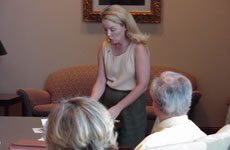Restorative Justice
Victim Offender Conferencing
What is Victim-Offender Conferencing?
The first court-connected victim-offender conferencing program in Alabama was begun by Judge Tracy McCooey at the circuit court in Montgomery County.  This program has an excellent track record, and other counties may receive the model plans upon request.Victim-offender conferencing allows individuals directly affected by crime to actively participate in dealing with the consequences of the crime. Trained facilitators are assigned to each case to assist all parties in the conferencing process. Assisted by facilitators, the parties most affected by an offense are provided an opportunity to safely meet to discuss:
This program has an excellent track record, and other counties may receive the model plans upon request.Victim-offender conferencing allows individuals directly affected by crime to actively participate in dealing with the consequences of the crime. Trained facilitators are assigned to each case to assist all parties in the conferencing process. Assisted by facilitators, the parties most affected by an offense are provided an opportunity to safely meet to discuss:
- What happened
- How they felt when it happened
- How they feel now
- What is needed for restitution, restoration and healing
- The goal is to restore harmony, discover truth and end intolerable behaviors.
What is Restitution?
In victim-offender conferencing, the word restitution means that victims and offenders decide together what is fair and what can be accomplished so the offender can attempt to repair the harm done. This could men the offender: contracts to repay a cash amount to replace the victim's out-of-pocket losses; does community or personal service work; participates in a creative plan that both victim and offender agree upon.
WHY WOULD ANYONE WANT TO DO THIS?
Conferencing can bring peace of mind and a sense of restoration to all parties. Victims often report their loss as more than what can be measured by material goods or financial cost. This is not usually dealt with in the courtroom. Also, most victims want to know if they have reason to fear the offender in the future. It is important to remember that the word "victims" can include family members or loved-ones of someone who is no longer here. Offenders usually don't learn about the human cost of their actions in the courtroom. Conferencing allows a process through which offenders fully realize that cost and attempt to make things right again. When victims hold offenders accountable and offenders take responsibility for their actions then the healing process begins.
HOW DOES THIS WORK?
Participation is strictly voluntary.Before a conference, the facilitator will: set the rules; listen to each person explain how they were affected by what happened; explain the program. During a conference, the facilitator will set the rules; ensure safety and fairness for all involved; help the parties develop and write any agreements and/or recommendations for the court.When a case is referred for conferencing the facilitator will
- Arrange a separate meeting with each person involved
- Clarify the status of a case
- Explain the conferencing process
- Make scheduling arrangements Assure that all parties have uninterrupted time to speak
- Document any agreements or recommendations which are agreed upon
- Provide each participant with a copy of their agreements or recommendations
What does a Facilitator Do?
 A facilitator is a neutral person who is present at a conference to moderate, provide safety, and help others effectively communicate. Facilitators are skilled in the conferencing process, good listeners who are respectful, and bound by confidentiality. They do not take sides, make decision for either side, or impose agreements between the parties.
A facilitator is a neutral person who is present at a conference to moderate, provide safety, and help others effectively communicate. Facilitators are skilled in the conferencing process, good listeners who are respectful, and bound by confidentiality. They do not take sides, make decision for either side, or impose agreements between the parties.
"The current criminal justice system does not focus on how crime harms or destroys relationships with the context of the community. When court proceedings end, the victim's pain continues and questions can be left unanswered. Often, offenders do not fully understand or take responsibility for their actions. Hopefully, this community justice program will provide an opportunity for the victim, the offender, the court, and the community to take part in the process of repairing the fabric of community peace... together."
